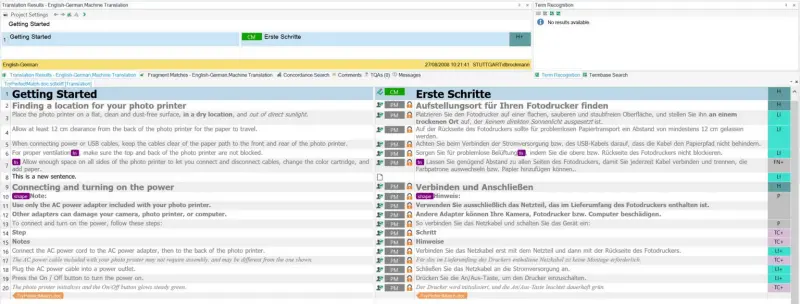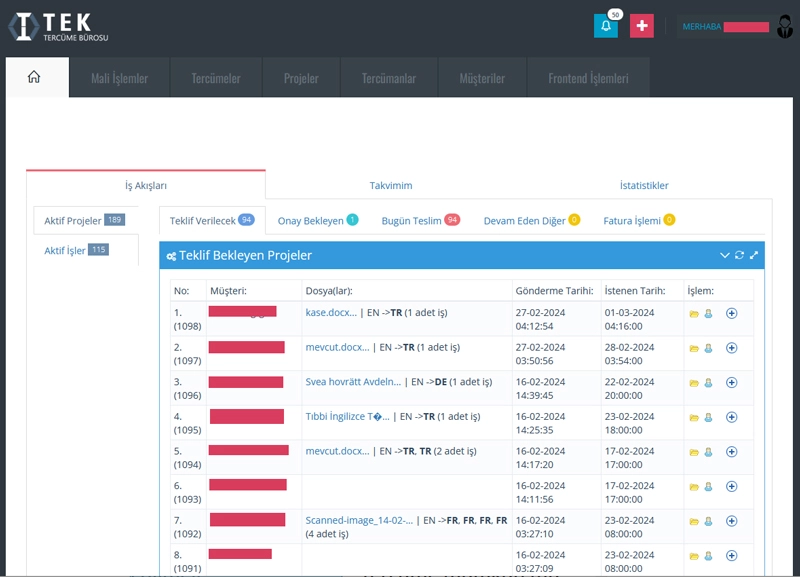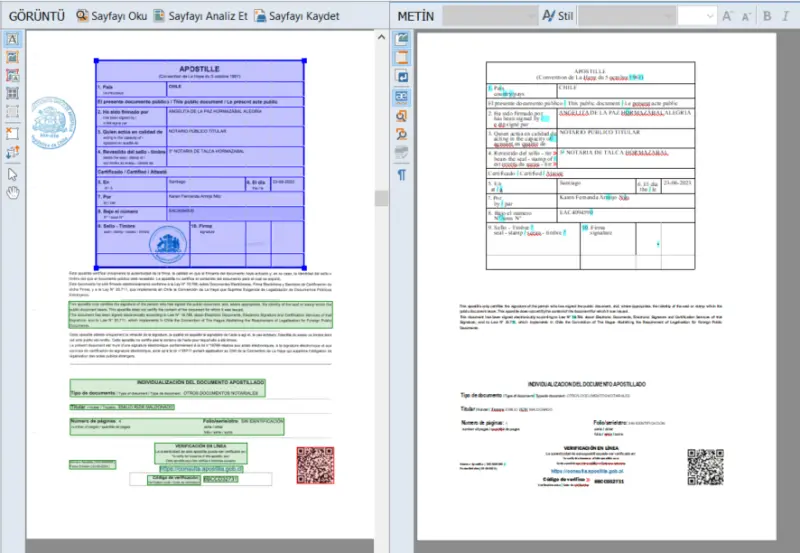-
-
Admin
- 0
Current technologies and tools used in the translation industry
Smooth communication is a vital requirement for building commercial, political, and cultural connections in the globalized world. Achieving seamless and precise communication among countries, organizations, and individuals necessitates overcoming linguistic barriers through swift and high-quality translations. In the current digital age, leveraging both established and emerging technologies and tools facilitates the process of translation.
In this article, we will initially delve into the realm of Computer-Aided Translation (CAT) tools, quality assurance, and project management tools. Additionally, we will explore the burgeoning influence of artificial intelligence (AI) on the translation industry. These advancements, integrated with existing tools, are steadily gaining effectiveness and prevalence. We'll also engage in speculation about the transformative role technology has played in translation and its potential contributions in the future.
Overview of Available Technologies and Tools
Computer Aided Translation (CAT) Sofware
CAT is an approach employing computer tools and software, aids translators in their translation process. Essentially, it relies on maintaining all translations in databases known as Translation Memory and TermBase, facilitating reusability. When a translator encounters a similar sentence already stored in memory, there's no need to start the translation from scratch. This approach results in significant time and effort savings, particularly when dealing with documents containing similar expressions. The translator proceeds by modifying the previous translation as necessary. Moreover, if the equivalent of a previously used term appears in the term bank, it is used as is, avoiding the need to search for its meaning and potential alternative translations. This ensures terminological consistency across different documents.
These tools operate by breaking down the content into segments, each consisting of one or a few sentences. These segments are referred to as segments, and the process of dividing them is known as segmentation. In the software interface, users observe these segments organized into rows within a table, with columns labeled source and target. The translator then proceeds to input the translation of the source content into the corresponding target cell for each line. Expressions and terms from the memory related to the active line are displayed in other sections of the interface. Furthermore, any potential inconsistencies or errors between the source and target cells are presented on a row-by-row basis. This approach grants the translator independence from the visual structure in the source file. Once the translation is complete, the CAT program saves the file in the target language, ensuring exact compatibility with the original source file.

Interface Example of a CAT Tool Certain CAT tools provide collaboration features online, where translated content is stored in cloud-based environments. Users connecting to the system from various locations have the capability to collaborate on different segment groups within a single document simultaneousl.
The industry's most renowned CAT tools include SDL Trados Studio, memoQ, Wordfast, and OmegaT programs. Professional translation agencies should undoubtedly leverage these programs to deliver swift, high-quality, and, above all, consistent translations. Tek Translate enhances its efficiency by effectively utilizing these software tools as integral components of the quality translation process.
Translation Areas Where CAT Tools Are Utilized
Given its features, we can discuss the translation areas where a CAT tool proves more beneficial and necessary. The primary criterion for deriving benefit and necessity is the presence of multiple files with similar content and structure in the project. Consequently, they find extensive use in the following areas and file types:
- Technical Content: Documents produced by companies in sectors such as machinery, chemistry, and software share similarities in terms of content and format. For instance, a machine manufacturer's product range comprises machines produced for the same purpose but with different models. Consequently, the technical documentation of their products will exhibit considerable similarities. This pattern is also applicable to chemical products, software, and automotive catalogues. By storing the repetitive segments of technical translations, such as user manuals, specifications, product catalogs, and information forms, in a translation memory, it becomes possible to utilize the translations in new projects. This not only shortens translation times but also ensures terminology consistency across a company's document sets.
- Financial and Commercial Documents: In the financial sector, especially in documents related to banking, investment, and accounting transactions, similar contents are frequently encountered. For instance, the contents of headings and financial item lines in tables in annual activity reports often remain unchanged, with variations primarily in numerical amounts. Similarly, valuation reports for the same type of real estate consist of sections that do not significantly differ. Storing these texts and their translations in memory facilitates financial translations, making the process more efficient and faster.
- Websites: Web pages, especially those designed for e-commerce, often feature repetitive sections. While specific details vary across the pages of numerous listed items such as products, real estate, and services, certain areas such as titles, dimensions, payment options, returns, and exchanges remain consistent. Translating website contents using CAT tools ensures the use of a uniform language across all pages.
The utilization of these tools may also be necessary in medical, legal, and official document translations.
Project Management Systems (TMS - Translation Management Systems)
Project management systems employed in translation offices serve as platforms designed to centralize and streamline the monitoring of translation and localization processes. These systems establish a collaborative working environment among project managers, translators, and translation teams, offering a comprehensive workflow that encompasses file management and customer relations. Integration with CAT tools is also a common practice. Typically stored in cloud environments, these systems facilitate collaboration among users from different locations.
The key features of these systems encompass:
- Project Management: TMSs provide tools for planning, organizing, and controlling translation projects. Project managers can assign tasks, set deadlines, and monitor the progress of translations from this centralized platform.
- File and Content Management: TMS manages various file formats and content types, ensuring compatibility with different document types, websites, software applications, and multimedia content.
- Translation Memory (TM) Integration: Advanced TMSs may include Translation Memory systems, allowing previously translated sections to be stored and transferred between projects. This ensures consistency between projects within the same branch and prevents unnecessary data storage.
- Terminology Management: TMSs may feature databases to store and manage industry-specific terms. This facilitates the consistent and instantaneous use of terminology, especially beneficial in large projects with similar content.
- Collaboration and Workflow: TMS facilitates seamless collaboration between translators, editors, and project managers. Real-time collaboration, crucial in comprehensive and time-sensitive projects, can be implemented efficiently.
- Quality Assurance: TMS tools incorporate features for quality assurance checks, ensuring translations meet established standards. They contribute to overall quality control, maintain consistency of style, and adhere to industry standards
- Integration with CAT Tools: TMSs can integrate with CAT tools, facilitating a smoother translation process by exchanging data from translation memories and other language sources.
- Reporting and Statistics: TMS allows tracking of project performances, resource usage, and other important measurements. Reporting and statistical evaluations help optimize translation processes over time.
At Tek Translate, we manage our projects through an in-house-developed online system. Interactive transactions on our website are seamlessly recorded in this system, allowing us to instantly access the files and messages sent by our customers. The files undergo automatic processing, enabling us to swiftly generate pricing and present an offer to the customer. Upon approval of offers, we efficiently distribute tasks among our registered translators using the system.
Our project managers have a comprehensive view of all ongoing, due, and completed projects through the management screen, allowing them to progress their processes online. We can assess our work calendars, daily, weekly, and monthly work statistics with detailed graphics. Opting to develop our own system, rather than relying on commercial off-the-shelf software used in the translation industry, has proven advantageous. Over approximately 5 years, we have continuously refined and developed this platform according to the needs of our office, translators, and customers, resulting in a perfected system.

Project Management System Developed by Tek Translate Optical Character Recognition (OCR) Tools
In the requests received by our translation office, we often encounter scanned or photo-saved files. To ensure error-free and rapid translations, it is essential to transfer the text from these files to word processing programs using character recognition software. Essentially, this involves making PDF and image files editable in programs such as Word and Excel. Tek Translate employs the desktop application ABBYY FineReader for these processes. With ABBYY, we can produce documents with a layout that is fully compatible with the original. The program's image processing features enable us to render even poorly scanned and therefore illegible pages readable and processable. We can swiftly process the text sections to be translated, formatting them into plain text and tables, making them ready for translation in a matter of minutes.

Character recognition process in ABBYY program Current developments: Neural Networks and Machine Translation
Neural networks, based on AI-supported deep learning, have ushered in a revolution in the industry by significantly enhancing the translation capacity of machines. AI now possesses the ability to comprehend and interpret texts more effectively, utilizing advanced language models and natural language processing techniques. Consequently, it can offer users instant translations with more meaningful content than ever before.
While it might seem that AI has the potential to entirely replace human labor, especially given its advantages in terms of time and cost, it falls short of rendering human translation entirely unnecessary. Machine algorithms may struggle to grasp context as comprehensively as humans, particularly in complex content. Depending on the translation's purpose, nuances that need to be considered may escape algorithmic detection. Cultural, political, and sociological nuances may play a crucial role in the intended use of the translation. There might be a desire to employ different sentence and paragraph structures in the target text compared to the original text, a necessity that becomes even more pronounced in services categorized as localization, rather than literal translation. Due to all these requirements, human translation remains indispensable.
For content that is not specific to a particular field of expertise and requires a general understanding, machine translation can be a quick and cost-effective solution. However, for critical translations involving private and public institutions, as well as legal or medical documents that have a significant impact on individuals' lives, seeking support from professional companies or translators is crucial. The machine might miss nuances that could lead to serious problems and incur substantial costs.
As of today, machine translation yields the best results when integrated with existing tools and combined with human expertise. While it's conceivable that in the near future, machine capabilities may reach a point where human intervention becomes unnecessary, current AI processes, despite their increasing perfection, come with rising background server, computation, and R&D costs. Thus, it seems premature to expect flawless solutions that entirely replace human involvement.
Nevertheless, the swift pace of technological development may necessitate updating this article in the future. Until then, Tek Translate remains committed to providing professional translation solutions and will continue to stand by your side.
Write a comment
-
- Translation Hotline: +44 0755 319 5602
- WhatsApp: +90 541 473 0337
-
- Customer LoginTranslator Login
Current translation technologies and tools
2024 © tektranslate.com - TEK ÇEVİRİ TERCÜME DANIŞMANLIK VE BİLİŞİM HİZMETLERİ TİC. LTD. ŞTİ.
Comments
There are no comments yet on this blog post. You can be the first to comment using the form below.